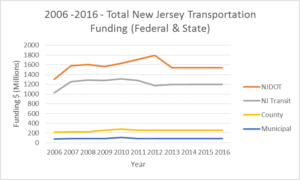“Local Street Repair Cost” Paper at 2017 TRB Meeting
Peters, Peters and Gordon to present paper at TRB
Carl E. Peters, P.E., and co-authors Jonathan R. Peters, Ph.D. and Cameron Gordon, Ph.D. will be presenting their paper “Who should pay for the local street? Who does? A survey of New Jersey municipalities” at the annual meeting of the Transportation Research Board in Washington, DC, in January 2017.
About TRB
According to its website, The Transportation Research Board (TRB) “is one of seven program units of the National Academies of Sciences, Engineering, and Medicine, which provides independent, objective analysis and advice to the nation and conducts other activities to solve complex problems and inform public policy decisions.”The mission of the Transportation Research Board (TRB) is to promote innovation and progress in transportation through research.”
How Much Does It Cost to Maintain New Jersey’s Local Streets?
The paper, which is based upon a study the team performed for the New Jersey Society of Municipal Engineers, quantifies the cost to keep New Jersey’s local streets in good repair. The report establishes the cost to maintain an average mile of a local street in New Jersey for a sixty year life span, It then projects the annual repair repair cost for all municipally maintained roads by multiplying the cost per mile by the total length of streets in municipal jurisdiction. The resulting annual need is a staggering $1.2 billion.
How is Transportation Funded in New Jersey?
The paper includes an analysis of the current revenue sources available for the upkeep of municipal streets, along with State and County roadways and New Jersey Transit.
The New Jersey Department of Transportation (NJDOT) 2010 listing of roadway mileage by jurisdiction shows that approximately 29,000 of the state’s 39,000 miles of roadway’s are maintained by municipalities. In 2014, State and Federal Aid to municipalities for local street repairs was less than $100 million. The remaining revenues to fix local streets must come from municipal budget sources, primarily property taxes.
Are Current Funding Methods Fair?
The paper raises the question “Who benefits from local streets?” as well as “Do all of the parties that benefit from local streets pay their fair share of maintenance costs?”
Only about 3% of New Jersey’s Transportation funding from state and federal sources is distributed to municipal governments.(see graph below for the period 2006 -2016),

NJ Transportation Funding 2006 -2016
New Jersey Department of Transportation records indicate that in 2014 approximately 15% of average daily traffic was carried by local streets.
The network of New Jersey’s municipal roads is extensive. Most vehicular trips have either an origin or destination on a local street. Local streets serve emergency services, commerce and other regional travel. Municipalities must maintain over 70% of New Jersey’s road mileage. These local streets carry over 15% of the vehicular trips per day. While noting that State and County roads are generally wider and carry larger volumes of truck traffic, it appears that New Jersey’s municipalities are being shortchanged when it comes to the distribution of funds for transportation.
What does the future hold for funding of local street repairs?
This paper has identified that we have much work to do to address efficient funding for local streets, sidewalks and curbs in particular. It is clear that the deferred maintenance and ongoing investment challenges are extensive and that the funding gap is massive. Yet these needs are largely ignored on the state and federal level; thus these costs and problems are left to the local governments. Like many state and federal unfunded mandates, the local governments then have to struggle to find funding sources to address problems that are not always just local in scope.

 D5 Creation
D5 Creation